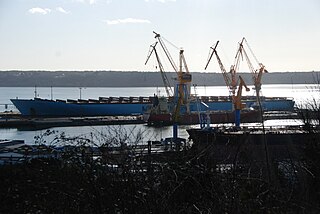
A straight-12 engine or inline-12 engine is a twelve-cylinder internal combustion engine with all twelve cylinders mounted in a straight line along the crankcase.

A straight-12 engine or inline-12 engine is a twelve-cylinder internal combustion engine with all twelve cylinders mounted in a straight line along the crankcase.
A straight-12 is a very long engine, and therefore straight-12 engines are extremely rare in automobiles, the first recorded being the Corona [1] made available in France in 1920. It displaced 7,238 cubic centimetres (441.7 cu in), but it is not known if any were sold. Packard also experimented with an automobile powered by an inline 12 in 1929. [2] The straight-12 has also been used for large military trucks.
Some Russian firms built straight-12s for use in ships in the 1960s and 1970s. MAN Diesel & Turbo 12K98ME and 12S90ME-C and the Wärtsilä-Sulzer RTA96-C are examples of contemporary marine engines in L-12-cylinder configuration. These are popular for propulsion in container ships. [3] [4] Wärtsilä-Sulzer has even made the world's so far only L-14 configuration. [5]

A V12 engine is a twelve-cylinder piston engine where two banks of six cylinders are arranged in a V configuration around a common crankshaft. V12 engines are more common than V10 engines. However, they are less common than V8 engines.

The straight or inline engine is an internal combustion engine with all cylinders aligned in one row and having no offset. Usually found in four, six and eight cylinder configurations, they have been used in automobiles, locomotives and aircraft, although the term in-line has a broader meaning when applied to aircraft engines, see Inline engine (aviation).

A V engine, sometimes called a Vee engine, is a common configuration for internal combustion engines. It consists of two cylinder banks—usually with the same number of cylinders in each bank—connected to a common crankshaft. These cylinder banks are arranged at an angle to each other, so that the banks form a "V" shape when viewed from the front of the engine.
The engine configuration describes the fundamental operating principles by which internal combustion engines are categorized.

The straight-eight engine or inline-eight engine is an eight-cylinder internal combustion engine with all eight cylinders mounted in a straight line along the crankcase. The type has been produced in side-valve, IOE, overhead-valve, sleeve-valve, and overhead-cam configurations.

A straight-four engine is a four-cylinder piston engine where cylinders are arranged in a line along a common crankshaft.

Sulzer Ltd.[ˈzʊlt͡sɐ] is a Swiss industrial engineering and manufacturing firm, founded by Salomon Sulzer-Bernet in 1775 and established as Sulzer Brothers Ltd. in 1834 in Winterthur, Switzerland. Today it is a publicly traded company with about 180 manufacturing facilities and service centers around the world. The company's shares are listed on the Swiss Stock Exchange.
The Wärtsilä RT-flex96C is a two-stroke turbocharged low-speed diesel engine designed by the Finnish manufacturer Wärtsilä. It is designed for large container ships that run on heavy fuel oil. Its largest 14-cylinder version is 13.5 meters high, 26.59 meters long, weighs over 2,300 tons, and produces 80080 kilowatt. The engine is the largest reciprocating engine in the world.
A straight-14 engine or inline-14 engine is a fourteen-cylinder internal combustion engine with all fourteen cylinders mounted in a straight line along the crankcase. A straight-14 is a very long engine, and therefore only suitable for marine installations in large ships.

Wärtsilä Oyj Abp, trading internationally as Wärtsilä Corporation, is a Finnish company which manufactures and services power sources and other equipment in the marine and energy markets. The core products of Wärtsilä include technologies for the energy sector, including gas, multi-fuel, liquid fuel and biofuel power plants and energy storage systems; and technologies for the marine sector, including cruise ships, ferries, fishing vessels, merchant ships, navy ships, special vessels, tugs, yachts and offshore vessels. Ship design capabilities include ferries, tugs, and vessels for the fishing, merchant, offshore and special segments. Services offerings include online services, underwater services, turbocharger services, and also services for the marine, energy, and oil and gas markets. At the end of June 2018, the company employed more than 19,000 workers.

The Liberty L-12 is an American water-cooled 45° V-12 aircraft engine displacing 1,649 cubic inches (27 L) and making 400 hp (300 kW) designed for a high power-to-weight ratio and ease of mass production. It saw wide use in aero applications, and, once marinized, in marine use both in racing and runabout boats.
The K108ME-C is a proposed low speed two-stroke turbocharged marine diesel engine for marine propulsion and power generation applications. It is designed by the Danish department of the German diesel engine supplier MAN SE.

An inboard motor is a marine propulsion system for boats. As opposed to an outboard motor where an engine is mounted outside the hull of the craft, an inboard motor is an engine enclosed within the hull of the boat, usually connected to a propulsion screw by a driveshaft.
A straight-nine engine or inline-nine engine is a straight engine with nine cylinders. Straight-nine engines are usually diesel engines used for ship propulsion. Rolls-Royce Marine Engines, Pielstick and Wärtsilä have made this type of engine.

Emma Mærsk is the first container ship in the E class of eight owned by the A. P. Moller-Maersk Group. When launched in 2006, she was the largest container ship ever built, and in 2010 she and her seven sister ships were among the longest container ships. Officially, she is able to carry around 11,000 twenty-foot equivalent units (TEU) or 14,770 TEU depending on definition. In May 2010, her sister ship Ebba Mærsk set a record of 15,011 TEU in Tanger-Med, Tangier.

Gudrun Maersk is a container ship, capable of carrying 8,500 TEU and with a deadweight (DWT) of 115,700 metric tons. The ship was built in 2005 and is operated by the Maersk Line.

In aviation, an inline engine is a reciprocating engine with banks of cylinders, one behind another, rather than rows of cylinders, with each bank having any number of cylinders, although more than six is uncommon. The major reciprocating-engine alternative configuration is the radial engine, where the cylinders are placed in a circular or "star" arrangement.

A straight-seven engine or inline-seven engine is a straight engine with seven cylinders. Wärtsilä, with their RTA96-C, and MAN Diesel produce crosshead two-stroke diesel engines in this configuration. Wärtsilä also produces regular trunk engines in this configuration. It is more common in marine applications because marine engines are usually based on a modular design, with individual heads per cylinder.
A V14 engine is a V engine with 14 cylinders mounted on the crankcase in two banks of seven. It is a relatively rare layout, which is used on large medium-speed diesel engines used for power generation and marine propulsion.

Eleonora Mærsk is one of the world's largest container ships operated by A. P. Moller and registered to Svendborg, Denmark. It was constructed in 2006 at the Odense Steel Shipyard. There are seven other identical sister ships in the A. P. Moller fleet. Eleonora Mærsk and the other seven ships of the E class are among the biggest ever built.
{{cite web}}: CS1 maint: archived copy as title (link){{cite web}}: CS1 maint: archived copy as title (link)